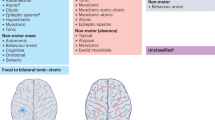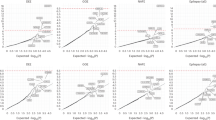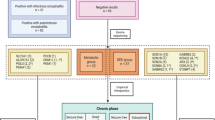Abstract
The classic epileptic encephalopathies, including infantile spasms (IS) and Lennox–Gastaut syndrome (LGS), are severe seizure disorders that usually arise sporadically. De novo variants in genes mainly encoding ion channel and synaptic proteins have been found to account for over 15% of patients with IS or LGS. The contribution of autosomal recessive genetic variation, however, is less well understood. We implemented a rare variant transmission disequilibrium test (TDT) to search for autosomal recessive epileptic encephalopathy genes in a cohort of 320 outbred patient–parent trios that were generally prescreened for rare metabolic disorders. In the current sample, our rare variant transmission disequilibrium test did not identify individual genes with significantly distorted transmission over expectation after correcting for the multiple tests. While the rare variant transmission disequilibrium test did not find evidence of a role for individual autosomal recessive genes, our current sample is insufficiently powered to assess the overall role of autosomal recessive genotypes in an outbred epileptic encephalopathy population.
Similar content being viewed by others
Log in or create a free account to read this content
Gain free access to this article, as well as selected content from this journal and more on nature.com
or
References
Epi4K Consortium. Epilepsy Phenome/Genome Project Epi4K Consortium. Epilepsy Phenome/Genome Project, Allen AS et al: De novo mutations in epileptic encephalopathies. Nature 2013; 501: 217–221.
EuroEPINOMICS-RES Consortium. Epilepsy Phenome/Genome Project. Epi4K Consortium: De novo mutations in synaptic transmission genes including DNM1 cause epileptic encephalopathies. Am J Hum Genet 2014; 95: 360–370.
Harkin LA, McMahon JM, Iona X et al: The spectrum of SCN1A-related infantile epileptic encephalopathies. Brain 2007; 130 (Pt 3): 843–852.
Epilepsy Phenome/Genome Project Epi4K Consortium: Copy number variant analysis from exome data in 349 patients with epileptic encephalopathy. Ann Neurol 2015; 78: 323–328.
Purcell S, Neale B, Todd-Brown K et al: PLINK: a tool set for whole-genome association and population-based linkage analyses. Am J Hum Genet 2007; 81: 559–575.
Jiang Y, Satten GA, Han Y et al: Utilizing population controls in rare-variant case-parent association tests. Am J Hum Genet 2014; 94: 845–853.
Jiang Y, McCarthy JM, Allen AS : Testing the effect of rare compound-heterozygous and recessive mutations in case—parent sequencing studies. Genet Epidemiol 2015; 39: 166–172.
Adzhubei IA, Schmidt S, Peshkin L et al: A method and server for predicting damaging missense mutations. Nat Methods 2010; 7: 248–249.
van Karnebeek CD, Shevell M, Zschocke J, Moeschler JB, Stockler S : The metabolic evaluation of the child with an intellectual developmental disorder: diagnostic algorithm for identification of treatable causes and new digital resource. Mol Genet Metab 2014; 111: 428–438.
Exome Variant Server (EVS), NHLBI GO Exome Sequencing Project (ESP), Seattle, WA, USA.
Zhu X, Petrovski S, Xie P et al: Whole-exome sequencing in undiagnosed genetic diseases: interpreting 119 trios. Genet Med 2015; 17: 774–781.
Need AC, Shashi V, Hitomi Y et al: Clinical application of exome sequencing in undiagnosed genetic conditions. J Med Genet 2012; 49: 353–361.
Tanaka AJ, Cho MT, Millan F et al: Mutations in SPATA5 are associated with microcephaly, intellectual disability, seizures, and hearing loss. Am J Hum Genet 2015; 97: 457–464.
Akawi N, McRae J, Ansari M et al: Discovery of four recessive developmental disorders using probabilistic genotype and phenotype matching among 4,125 families. Nat Genet 2015; 47: 1363–1369.
Acknowledgements
We are deeply grateful to the probands, their families, clinical research coordinators, and referring physicians for their participation and provision of phenotype data, and DNA samples used in this study. We thank the EPGP Administrative (C Freyer, K Fox, R Fahlstrom, S Cristofaro, and K McGovern), Bioinformatics Core (G Nesbitt, K McKenna, and V Mays), staff at Coriell Institute – NINDS Genetics Repository, and members of the Institute for Genomic Medicine, Columbia University (P Cansler, J Charoensri, B Copeland, S Kamalakaran, J Keebler, B Krueger, C Malone, C Mebane, and M Cook) for their dedication and commitment to this work. We also thank R Stewart, K Gwinn, R Corriveau, B Fureman, and V Whittemore from the National Institute of Neurological Disorders and Stroke for their careful oversight and guidance of both EPGP and Epi4K. We thank the following organizations for assistance in publicizing EPGP; enabling us to recruit participants effectively: AED Pregnancy Registry, American Epilepsy Society, Association of Child Neurology Nurses, California School Nurses Organization, Child Neurology Society, Citizens United for Research in Epilepsy, Dravet Syndrome Foundation, Epilepsy Alliance of Orange County, Epilepsy Foundation, Epilepsy Therapy Project, Finding a Cure for Epilepsy and Seizures, IDEA League, InfantileSpasms.com, Lennox–Gastaut Syndrome Foundation, PatientsLikeMe, People Against Childhood Epilepsy, PVNH Support & Awareness, and Seizures & Epilepsy Education. We would like to acknowledge the following individuals or groups for the contributions of control samples: D Daskalakis; P Lugar; J Milner; T Young and K Whisenhunt; Z Farfel, D Lancet, and E Pras; W Lowe; R Gbadegesin and M Winn; K Schmader, S McDonald, HK White, and M Yanamadala; A Holden; E Behr; C Moylan; AM Diehl and M Abdelmalek; S Palmer; G Nestadt; J Samuels; Y Wang; M Carrington; M Harms; T Miller; A Pestronk; R Bedlack; R Brown; N Shneider; S Gibson; J Ravits; A Gilter; J Glass; F Baas; E Simpson; and G Rouleau; K Welsh-Bomer, C Hulette, J Burke; The ALS Sequencing Consortium; The Murdock Study Community Registry and Biorepository; M Connors, L Morris, and the CHAVI investigators; the Carol Woods and Crosdaile Retirement Communities; and DUHS (Duke University Health System) Nonalcoholic Fatty Liver Disease Research Database and Specimen Repository. The collection of control samples and data was funded in part by: Biogen Idec.; The Duke Chancellor’s Discovery Program Research Fund 2014; Bill and Melinda Gates Foundation; The Division of Intramural Research; B57 SAIC-Fredrick Inc M11-074; Bryan ADRC NIA P30 AG028377; The Ellison Medical Foundation New Scholar award AG-NS-0441-08; National Institute of Mental Health (K01MH098126, R01MH097993); National Institute of Allergy and Infectious Diseases (1R56AI098588-01A1); and National Institute of Allergy and Infectious Diseases Center (U19-AI067854, UM1-AI100645). We thank the NHLBI GO Exome Sequencing Project and its ongoing studies that produced and provided exome variant calls for comparison: the Lung GO Sequencing Project (HL-102923), the WHI Sequencing Project (HL-102924), the Broad GO Sequencing Project (HL-102925), the Seattle GO Sequencing Project (HL-102926), and the Heart GO Sequencing Project (HL-103010). This work was supported by grants from the National Institute of Neurological Disorders and Stroke (The Epilepsy Phenome/Genome Project NS053998; Epi4K NS077364, NS077274, NS077303, and NS077276), The Andrew’s Foundation, Finding a Cure for Epilepsy and Seizures, the Richard Thalheimer Philanthropic Fund, and the Eurocores program EuroEPINOMICS-RES of the European Science Foundation. The project received further support through grants from the Fund for Scientific Research Flanders (FWO); the Academy of Finland (141549); the Folkhälsan Research Foundation; the program ‘Investissements d’avenir’ ANR-10-IAIHU-06; the Federal Ministry for Education and Research (IonNeurONet: 01GM1105), the German Research Foundation (DFG: HE5415/3-1; Le1030/11-1; RO3396/2-1), the German Society for Epileptology (DGfE), the Foundation noepilep.; the Swiss National Science Foundation (SNF: 32EP30_136042/1); the Wellcome Trust (09805); intramural funds of the University of Kiel; the Popgen 2.0 network (P2N) through the German Ministry for Education and Research (01EY1103); and the European Union through Seventh Framework Programme (FP7) under the project DESIRE (N602531). The project also received infrastructural support through the Institute of Clinical Molecular Biology in Kiel, supported in part by DFG Cluster of Excellence ‘Inflammation at Interfaces’ and ‘Future Ocean’. Orrin Devinsky, David B Goldstein, Steve Petrou and Slavé Petrovski have interests in companies related to epilepsy precision medicine.
Author contributions
Sequence analysis and statistical interpretation: YJ (lead analyst), ASA, and DBG. Bioinformatics processing: JBr, ELH, YJ, SlP, ZR, and QW. Clinical expert panel: IH, HCM, AP, and SW. Writing of manuscript: ASA, SFB, PDJ, DBG, ELH, IH, YJ, DHL, and SlP. Epi4K Steering Committee: ASA, SFB, PC, ND, DD, EEE, MPE, TG, DBG, ELH, MRJ, RuKu, DHL, AGM, HCM, TJO, RO, StP, SlP, AP, IES, and ES. EuroEPINOMICS-RES consortium leadership and study coordination: IH, PDJ, and SW. EuroEPINOMICS study design: A-EL, AS, BK, HL, IH, PG, PDJ, and SW. EPGP study design: BKA, OD, DD, MPE, RuKu, DHL, RO, ES, and MRW. Epi4K epileptic encephalopathy phenotyping: SFB, PC, DD, RuKu, DHL, HCM, RO, AP, IES, and ES. EuroEPINOMICS-RES proband recruitment and phenotyping: A-EL, AR, CM, CD, DC, DP, DH, EL, FZ, FRos, HC, HH, HM, HL, IH, JJ, JL, JS, KSe, KMK, KSt, NB, PS, RG, RSM, SvS, SW, SB, TL, TT, US, VK, and YW. EPGP proband recruitment and phenotyping: BA, EA, FA, DA, JFB, SFB, GDC, DCo, PCr, OD, DD, MEF, NBF, DF, EBG, TG, SG, SRH, JH, KH, SLH, HEK, RCKn, EK, RaKu, RuKu, DHL, SMM, PVM, EJN, JMP, JP, KP, AP, IES, JJS, RAS, JSi, LS, MS, LLT, AV, EPGV, GKV, JW, and PW. EPGP phenotype data analysis: BA, BKA, AB, JB, GDC, OD, DD, MPE, JF, TG, SJ, AK, RCKn, RuKu, DHL, RO, JMP, AP, IES, RAS, RS, ES, JJS, JSu, PW, and MRW.
Author information
Authors and Affiliations
Consortia
Ethics declarations
Competing interests
The sponsors of the study had no role in study design, data collection, data analysis, data interpretation, or writing of the report.
Additional information
Andrew S Allen, Samuel F Berkovic, Joshua Bridgers, Patrick Cossette, Dennis Dlugos, Michael P Epstein, Tracy Glauser, David B Goldstein, Erin L Heinzen, Yu Jiang, Michael R Johnson, Ruben Kuzniecky, Daniel H Lowenstein, Anthony G Marson, Heather C Mefford, Terence J O’Brien, Ruth Ottman, Steven Petrou, Slavé Petrovski, Annapurna Poduri, Zhong Ren, Ingrid E Scheffer, Elliott Sherr, Quanli Wang
Rudi Balling, Nina Barisic, Stéphanie Baulac, Hande Caglayan, Dana Craiu, Peter De Jonghe, Christel Depienne, Renzo Guerrini, Ingo Helbig, Helle Hjalgrim, Dorota Hoffman-Zacharska, Johanna Jähn, Karl Martin Klein, Bobby Koeleman, Vladimir Komarek, Roland Krause, Eric Leguern, Anna-Elina Lehesjoki, Johannes R Lemke, Holger Lerche, Tarja Linnankivi, Carla Marini, Patrick May, Rikke S Møller, Hiltrud Muhle, Deb Pal, Aarno Palotie, Felix Rosenow, Kaja Selmer, Jose M Serratosa, Sanjay Sisodiya, Ulrich Stephani, Katalin Sterbova, Pasquale Striano, Arvid Suls, Tiina Talvik, Sarah von Spiczak, Yvonne Weber, Sarah Weckhuysen, Federico Zara
Bassel Abou-Khalil, Brian K Alldredge, Dina Amrom, Eva Andermann, Frederick Andermann, Jocelyn F Bautista, Samuel F Berkovic, Judith Bluvstein, Gregory D Cascino, Damian Consalvo, Patricia Crumrine, Orrin Devinsky, Dennis Dlugos, Michael P Epstein, Miguel E Fiol, Nathan B Fountain, Jacqueline French, Daniel Friedman, Tracy Glauser, Kevin Haas, Sheryl R Haut, Jean Hayward, Sucheta Joshi, Andres Kanner, Heidi E Kirsch, Eric H Kossoff, Rachel Kuperman, Ruben Kuzniecky, Daniel H Lowenstein, Shannon M McGuire, Paul V Motika, Edward J Novotny, Ruth Ottman, Juliann M Paolicchi, Jack Parent, Kristen Park, Annapurna Poduri, Ingrid E Scheffer, Renée A Shellhaas, Elliott Sherr, Joseph Sirven, Michael C Smith, Joseph Sullivan, Liu Lin Thio, Anu Venkat, Eileen PG Vining, Gretchen K Von Allmen, Judith L Weisenberg, Peter Widdess-Walsh, Melodie R Winawer
Rights and permissions
About this article
Cite this article
Epi4K Consortium., EuroEPINOMICS-RES Consortium. & Epilepsy Phenome Genome Project. Application of rare variant transmission disequilibrium tests to epileptic encephalopathy trio sequence data. Eur J Hum Genet 25, 894–899 (2017). https://doi.org/10.1038/ejhg.2017.61
Received:
Revised:
Accepted:
Published:
Issue date:
DOI: https://doi.org/10.1038/ejhg.2017.61
This article is cited by
-
The role of recessive inheritance in early-onset epileptic encephalopathies: a combined whole-exome sequencing and copy number study
European Journal of Human Genetics (2019)



